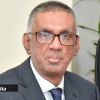[[{"type":"media","view_mode":"media_large","fid":"19038","attributes":{"class":"media-image wp-image-32640 alignleft","typeof":"foaf:Image","style":"","width":"305","height":"210","alt":"construction"}}]]Port development
DP World is interested to participate in the development of Port Louis. The development includes: a Special Economic Zone over 325 acres at Riche-Terre through a joint venture with the Government of Mauritius for a lease of 99 years is modelled after the Jebel Ali Free Zone of Dubai, with initial investments of at least USD 23 million for the first six years. An additional investment of USD 37 million is later expected. According to the figures provided, this area will attract potential investment of USD 450 million and create 8,000 jobs. DP World also wants a management contract for port operations for a period of 30 years. This includes the investment of USD 25 million for a container terminal to increase capacity. Another USD 500 million is planned to expand the terminal by 2030.
Publicité
Private projects announced for 2016
In December 2015, the Investment Fast Track Committee chaired by the Financial Secretary Dev Manraj approved fifty projects that require a total investment of Rs 68 billion. These projects will be developed over the next three years. Among them: Yihai Smart City It is unclear whether the Yihai Smart City, a project to transform Domaine Les Pailles will see the light of day. A joint-venture between Yihai Investment and the SIC, Yihai has already obtained its letter of approval from the Board of Investment. However, in March, the Cabinet decided not to go ahead with the project. Medina Smart City This is an Educational Village which will house private universities and schools, surrounded by housing developments, shopping centres and sports complexes. Cost: Rs 5 billion. Deep Ocean Water Application This project concerns the pumping of deep sea water from a depth of 1,000 metres for use in air conditioning of buildings in the capital. Cost: Rs 4 billion Roches Noires Smart City This project includes the construction of a 300-room hotel, apartments, villas and shopping malls. Cost: Rs 3 billion. Trianon City Designed by Hermes Properties, the project will include office blocks, residential units, campus, medical facilities, a jogging track and a corner dedicated to innovation and start-ups. Cost: Rs 3 billion. St. Felix Smart City Another Smart City with residential units commercial spaces and leisure centres. This project includes a university specialised in oceanography and a hotel. Cost: Rs 2 billion. Haute Rive Holdings Ltd Part of the Master Plan Azuri, the project includes residential, commercial, educational, medical, and recreational zones. Cost: Rs 2 billion. Mont Choisy Smart City Mont Choisy Smart City project involves the construction of 1,303 residential units including a 'retirement village’ of 383 units and a solar farm. Cost: Rs 1 billion.The Future of Cities: How to avoid high-tech 'crash and burn' ghost towns
Patience is a virtue when creating up-to-date centres that will stand the test of time. Yamoussoukro in Ivory Coast is a city with roads wide enough for jumbo jets to land on, a vast presidential palace and a basilica modelled on St Peter’s in Rome. However, while it was named the nation’s capital in 1983, most commercial and administrative activities still take place in another city, Abidjan. [[{"type":"media","view_mode":"media_large","fid":"19039","attributes":{"class":"media-image aligncenter wp-image-32641","typeof":"foaf:Image","style":"","width":"613","height":"260","alt":"The Future of Cities"}}]] Yamoussoukro’s failure to become the country’s primary urban centre is an example of how grand plans for new cities do not always live up to expectations. From the ghostly eco-cities of China to Malaysia, where Cyberjaya, built as the country’s version of Silicon Valley, has so far failed to thrive, there is plenty of evidence of how difficult it is to create a city from scratch. “A lot of them are not filling in as expected,” says Sarah Moser, director of urban studies at Canada’s McGill university, who, with her students, is compiling a new cities database. On paper, the points for such greenfield developments are strong. Pressure is growing to house rapidly expanding urban populations, particularly in emerging economies. Policymakers in these countries have seized on building high-tech cities as a way of joining the club of wealthier nations. “Since the 1990s, and increasingly in the past 10 years, this has become a staple financial strategy for countries in the ‘global south’,” says Ms Moser. “It’s seen as a way to leapfrog the economy from the production of raw materials and manufacturing into this new, high-tech era.” As cities produce more than 70 per cent of the world’s human-generated carbon emissions, according to UN-Habitat, attempts are also being made to design “green” or “carbon-neutral” cities such as Masdar in Abu Dhabi. Yet for Dirk Hebel, assistant professor of architecture and construction at Singapore’s Future Cities Laboratory, Masdar and similar projects borrow too much from older European models. He says we should not build large-scale cities in defined locations – so drawing on the principles of older cities that needed defensive walls – but plan smaller settlements, some of which may grow, some of which may merge and some of which may stay small. Mr Hebel argues that, while urban planners must still provide infrastructure such as transport systems, health and education services, developments should be more organic. “It should be a system not a single location.” Another challenge for new cities is persuading people to move into them. “You can populate those cities in China but you need to put [people] in buses and make sure they don’t leave,” says Michele Acuto, director of University College London’s city leadership initiative. He thinks building new cities is a flawed concept. “You could spend exactly the same amount on improving current structures and systems and fostering innovation in existing places.” But Ms Moser points to some promising examples, such as Yachay, north of Ecuador’s capital Quito, planned as a centre for scientific, academic, economic and technological research and innovation. Much of its focus has been on sustainability and planting local species to minimise water use. But Ms Moser believes another factor may aid Yachay’s success. Unlike many new cities, it is integrating its existing residents rather than moving them on. Agricultural workers, who may lose jobs once the city expands on to farmland, are being given work in composting plants or raising saplings for the city’s street trees. Others can take courses to give them the skills to open businesses. How many of the almost 150 brand new cities in her database does Ms Moser think will succeed? “It’s really too soon to tell,” she says. “One of the keys for what makes a successful city is that it needs patient capital,” says Suzanne Gill, a partner at law firm Wedlake Bell, who runs debates aimed at stimulating discussion about long-term sustainable investments. “Some of these [new] cities are like young men in hurry,” she says. “And some will crash and burn.” Copyright The Financial Times Limited 2016
Notre service WhatsApp. Vous êtes témoins d`un événement d`actualité ou d`une scène insolite? Envoyez-nous vos photos ou vidéos sur le 5 259 82 00 !






















![[En direct] Parlement : L’affaire Kistnen au coeur de la PNQ](https://defimedia.info/sites/default/files/styles/square_thumbnail/public/pnq_140524.jpg?itok=BllP2Scb)
